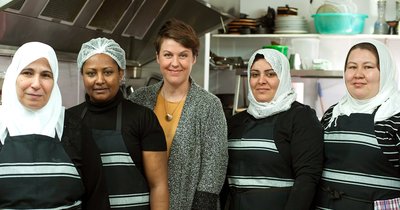Helping your child come to grips with the ins and outs of money management from an early age can set them on a path to long-term financial success. Including your child in conversations about the family finances from a young age is a good first place to start, says Banqer co-founder Kendall Flutey.
“You don’t need to go into depth, but it will mean you can start familiarising them with some of the vocabulary, concepts and responsibilities you face,” says Kendall.
Banqer is an online platform that is helping kids all over New Zealand develop positive relationships with money in the classroom. Kendall and the team at Banqer have created a platform where students get to simulate real-world financial situations such as saving, earning an allowance, balancing a bank account, and applying for jobs.
But financial education doesn't have to be confined to the classroom, Kendall shares her advice for sparking your child's interest in money management:
1. Start with an allowance
Your child’s first foray into the world of making money can be a fun and illuminating experience. The first thing to do is decide when to introduce an allowance, the amount you pay and what tasks to give them.
While this will differ for every family, a good rule of thumb is to start when your child is six-years-old. By this age they understand the concept of money, know what it’s like to wait for the thing they want, understand what ‘no’ means, and can count*.
But what chores do you give them?
None. Well, that’s not entirely true, but some experts suggest allowances shouldn’t be tied to normal household chores (such as washing the dishes or making their bed). They believe these are roles your child should carry out as members of the family. Allowances should be for ‘work’ you’d normally do yourself such as washing the car or mowing the lawns.
One of the first things teachers do when they introduce Banqer to students is set up what’s called a classroom “Basic Income.” To acquaint them with the concept of allowances, kids are rewarded for turning up to class, following class rules and being good class citizens.
It’s up to you to decide what constitutes a family job vs one deemed allowance-worthy. Whatever you choose, your child will start to understand the value of money and how you can earn it.
2. Establish some ground rules for spending
Now that they understand they can earn money from completing given tasks, the trick is to convince them it’s not all for lollies. But it's now their hard earned cash, which means they need to be given some freedom over how it’s spent, it's a real balance.
To make that responsibility a little easier for them, this is where some ground rules come in handy. The best step here is to agree with them on a percentage of their weekly income to put towards donating, saving and spending.
For example, they could donate 10%, save 30% and spend 60% then label three jars with the respective percentages. Not only with this money management thing now feel like serious business, having money they can see will mean they're able to keep track of the rise and fall of their finances, even motivating them to keep their jars full.
You might want to break down the spending percentage to certain items they’re ‘allowed’ to purchase. Beyond these ground rules it's good to initially let your child take the lead when it comes to how they spend their allowance – even if it looks like they’re going to overspend before their next ‘payday’.
Spending all their money before payday can be a good learning experience, especially if they find something they’d like to buy but have used up all their disposable income. They're in a low-risk managed situation, where even if they don't make the best initial money decisions, you now have opportunities to talk about the pitfalls of overspending and living beyond your means.
Talk about some of your own financial misadventures – if you have any – and how you got through.
Reassure your child that everyone makes mistakes and that you’re still learning.
Donating a portion of their earnings teaches kids an important lesson about sharing and promotes a positive relationship with money as a tool for helping others. Like all other lessons, you should talk to your child about why it’s good to donate money and you can work with them to give to an issue they’re interested in. It'll also be a bit empowering for them as they're able to make a positive impact on the world around them.
Whatever approach you take to spending, saving and donating, make sure your child plays an active role in the decision-making. It’s okay if they sometimes go over budget or don’t hit their targets, just as long as you explain why and make it fun.
3. Set some savings goals
Turn their dreams into reality by helping your child understand what they can achieve by setting longer-term savings goals.
Set them up for success by making the goal achievable – probably no more than a few weeks. If you don’t, frustration can set in and your child will become unconvinced of the benefits of saving long-term.
As you probably remember, a few days can feel like forever for a kid!
You want them to understand the rewards of saving rather than feel deflated by not reaching their target. Whenever they add money to their savings jar, help them count how much they have and how much they need to reach their goal. Ask them if they’re happy sticking with their initial target, or whether they’d like to aim for something more expensive.
If they have a more expensive goal, which is going to take a bit longer, you could match their efforts every time they add to the jar. Depending on their age, this could be a good opportunity to open a savings account and talk about things like interest.
To prepare kids for the realities of managing a bank account, Banqer lets them save in a mock online account. The weekly income they receive from various classroom tasks is used to pay make believe bills such as desk rental or wifi. Some kids rise to the challenge straight away, others may go through bankruptcy to get there.
Whether in online accounts in the classroom or in jam jars at home, setting achievable savings goals is an important step in teaching kids how to effectively balance their accounts.
4. Bring your child into the family financial fold
Inevitably, there will come a day when your child asks you what you earn. Instead of batting away the question be upfront and tell them, but don’t leave it at that – explain how your income supports the family.
It's important that you outline what expenses need to be paid from that income such as rent/mortgage, utilities, groceries, tuition. If you want to provide a more concrete example of how your weekly/fortnightly/monthly income is divvied up, withdraw it from the bank and bring it home. Separate it according to each outgoing and start a conversation about budgeting.
To reinforce the importance of budgeting and make it a bit fun, you could make your child Chief Budgeting Officer for a family holiday or event. For example, you could agree on a total amount of money the family are allowed to spend while on holiday. Together decide what the money can be spent on – within the allocated budget. Your child’s role is to make sure everyone sticks to the budget, giving them a bit of responsibility and stepping their money management skills up to the next level.
Being transparent about your finances and showing your child where all the money goes will give them a better appreciation of what goes into keeping the family afloat. It’s also an opportunity to bring your family closer together.
5. The importance of a first job
An allowance is only the first step in your child’s journey to financial independence. At some point (with a little nudging) they’re going to look outside of the household for their pocket money. Remember every child matures at a different rate, has different capabilities and levels of confidence. Bear this in mind when you decide to float the idea of a first job – are they ready?
If they’re lucky they may have taken part in Banqer’s Careers and Employment module, which simulates entering the workforce. Teachers post a job within the platform, students put together a CV and apply for the position. If they’re successful they then have to meet the job requirements.
Of course your child doesn’t have to skip straight to a job that requires such formality – mowing your neighbour’s lawns or babysitting are pretty great first jobs. What Banqer does do is provide a safe environment for kids to experience the realities and responsibilities of working life. This extends to taxing kids for the ‘income’ they make in class, preparing them for the day they receive their very first paycheck. It’s a good idea to discuss tax at home as well and talk about how their income contributes to society as a whole.
A first job represents your child’s initial steps towards financial freedom and their entry into the ‘real’ world. They’ll be answerable to a boss, possibly have to work in a team environment and engage with the public. They’ll develop time management skills and improve or enhance their interpersonal communication. As a result, they’ll become more confident, capable and independent - Great skills for life!
It's money in the bank
Helping your child develop a healthy relationship with money from an early age really does create a positive and lasting impact on how they deal with financial matters later in life. You're preparing them for the real world of banks, landlords, and employers who can be much less forgiving. The lessons they learn, the experiences you share and wisdom you impart will help them make better, more informed decisions in adulthood.
Want to find out more? Read how Kiwibank and Banqer are working together to support the next generation of Kiwis on the Banqer site. You can also find out how to get Banqer and interactive financial literacy into a classroom you care about.
*These milestones will differ for each child.



